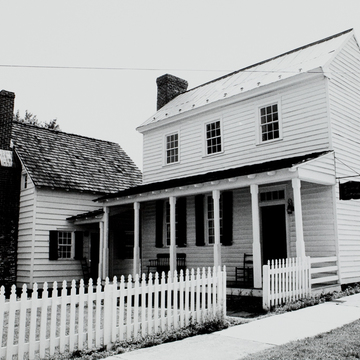A charmingly informal assemblage, the house consists of three separate little buildings connected by short, one-story porches. The presumed earliest portion is the one-and-one-halfstory log kitchen, now clapboarded, with a stone chimney, at the rear of the lot. A bricknogged frame structure, the dwelling, also oneand-one-half-stories tall but with a pair of brick chimneys, stands in front of the kitchen. Little is known of the origins of these two earliest components, which may predate Romney's founding. Andrew Woodrow, second owner of the property and third clerk of the Hampshire County Court, is credited with giving the complex its final and present form when he completed the last section, his “clerk's office,” in the 1780s. His two-story, frame office, with one brick chimney, stands at right angles to the dwelling, its narrow gable end flush on the sidewalk. It has a shed-roofed porch supported by chamfered columns, a side-hall plan, and an elegantly paneled fireplace wall in the main room. The additive quality of the complex is wonderfully forthright, and the group attests to Romney's very early settlement. All three buildings were restored in 1962.
You are here
Wilson-Woodrow-Mytinger House
c. 1750, 1780s, 1962. 51 West Gravel Ln. (north side of Gravel Lane between High and Marsham sts.)
If SAH Archipedia has been useful to you, please consider supporting it.
SAH Archipedia tells the story of the United States through its buildings, landscapes, and cities. This freely available resource empowers the public with authoritative knowledge that deepens their understanding and appreciation of the built environment. But the Society of Architectural Historians, which created SAH Archipedia with University of Virginia Press, needs your support to maintain the high-caliber research, writing, photography, cartography, editing, design, and programming that make SAH Archipedia a trusted online resource available to all who value the history of place, heritage tourism, and learning.














